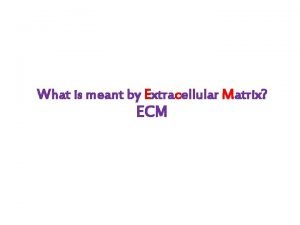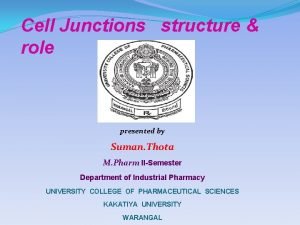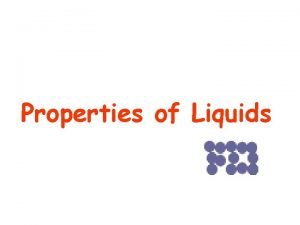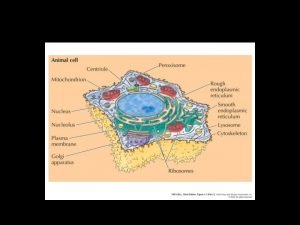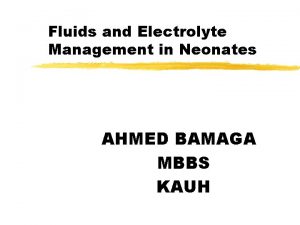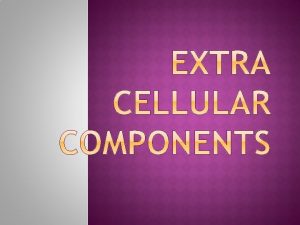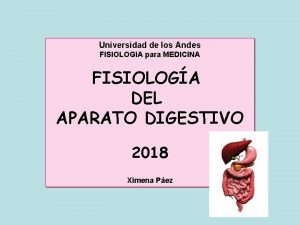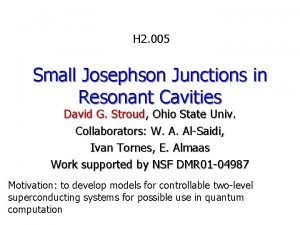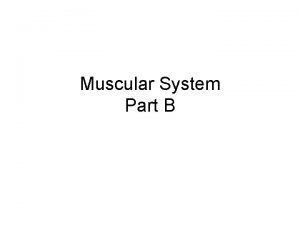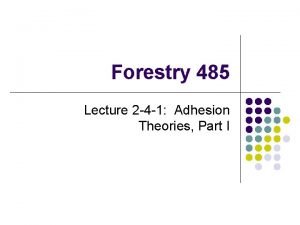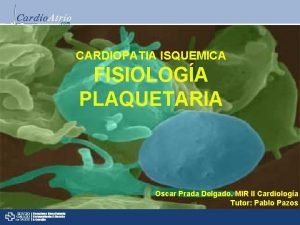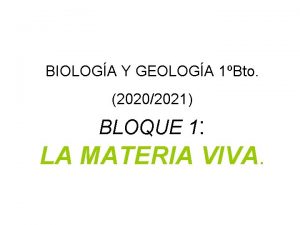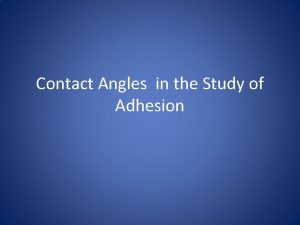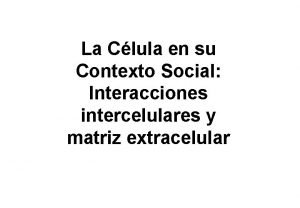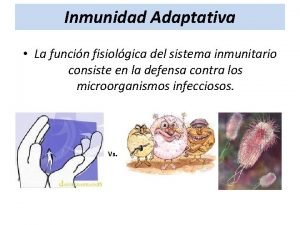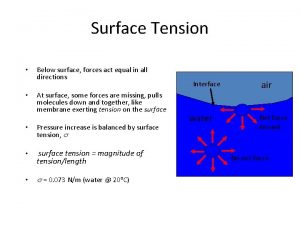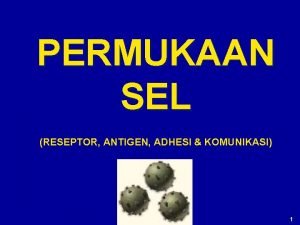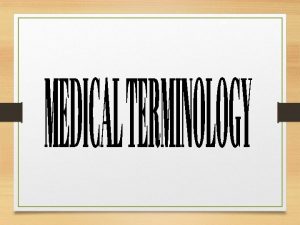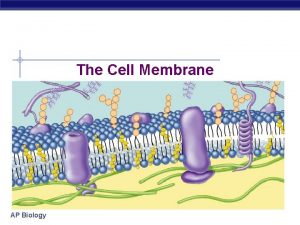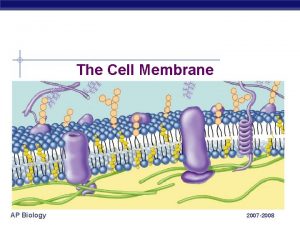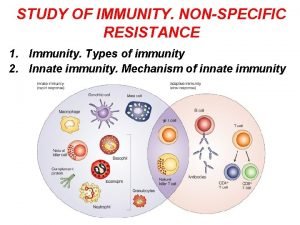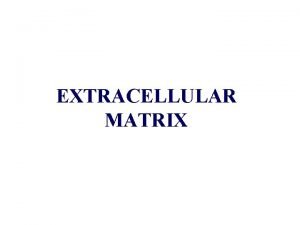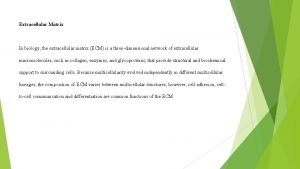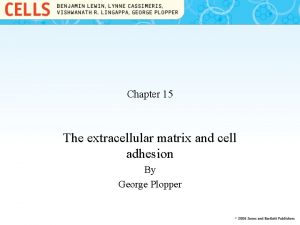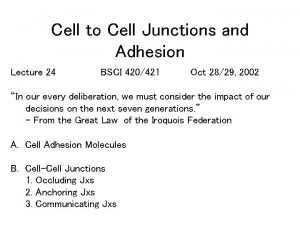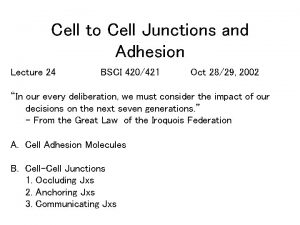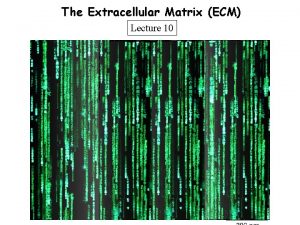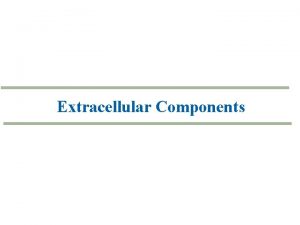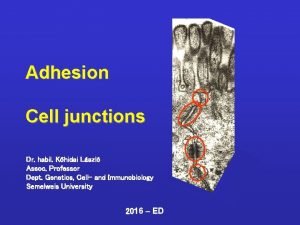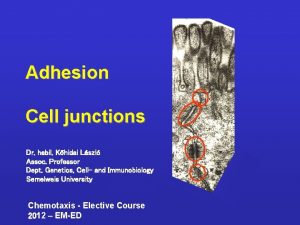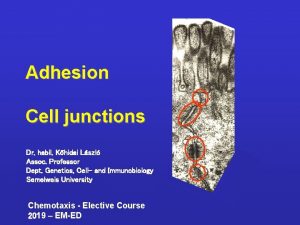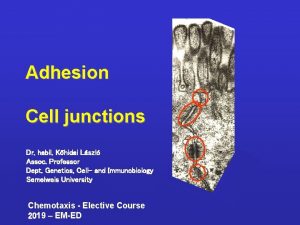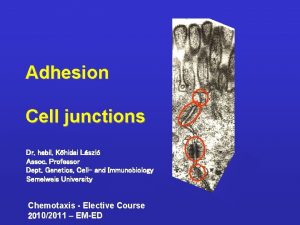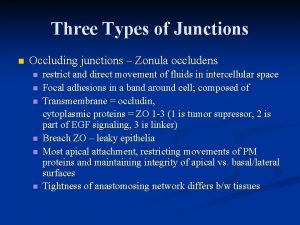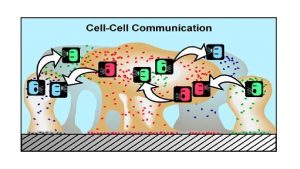Cell Junctions Cell Adhesion and the Extracellular Matrix













































- Slides: 45

Cell Junctions, Cell Adhesion, and the Extracellular Matrix Cell adhesion The c-adherins

Why is cell-cell adhesion so important to understand? • Migrating cells must reach, recognize, bind and stay with their target cells, tissues and organs! • Important implications in embryogenesis, cancer, infection, transplantation potentials (stem cells) and disease! • Tissue Development in the Embryo/Adult: • Epithelial cell to basal lamina: post burn skin • Neural crest cell in embryo: amputee nervous system • Endothelium and blood vessels: cancer • Pathway Guidance to Lead Cells Home: • Chemotaxis vs. Chemo-avoidance: • Ligands/Receptors/Second Messengers

Two main ways in which animal cells are bound together: • Connective tissue • Epithelial cells. Figure 19 -1 Molecular Biology of the Cell (© Garland Science 2008)

Four functional classes of cell junctions in animal tissues. Figure 19 -2 Molecular Biology of the Cell (© Garland Science 2008)

Table 19 -1 Molecular Biology of the Cell (© Garland Science 2008)

Summary of the various types of cell junctions in animals Figure 19 -3 Molecular Biology of the Cell (© Garland Science 2008)

There a variety of options available to cells when they seek to bind to other cells or know if they are in the correct location. Lets review some of the options available. Know one item that makes each unique. N-CAMS: Ca+Independent • Bind to other N-CAMS Cadherins: Ca-Dependent • Bind to other cadherins Selectins: don’t bind each other. Specialized to bind target glycoproteins Intergrins: bind laminin of the basal lamina or fibronectin in the ECM or to other cells.

The transmembrane adhesion molecules link the cytoskeleton to extracellular structures interactions Cadherins: cell-cell Integrins: cell-matrix movie Figure 19 -4 Molecular Biology of the Cell (© Garland Science 2008)

Table 19 -2 Molecular Biology of the Cell (© Garland Science 2008)

Compaction of an early mouse embryo. At the 8 -cell stage they start expressing E-cadherins Figure 19 -5 Molecular Biology of the Cell (© Garland Science 2008)

Cadherins are a class of Ca++Dependent cell-cell adhesion molecules which are important in embryogenesis. Their loss permits cells to migrate within the chick embryo to become muscle. Dimer anchored by tx-membrane sequences Localization of sub-types: E-epithelial N-neuronal P-placental VEendothelial For instance: N-cadherin binds to other Ncadherins, but not to E, P or VE-cadherins This keeps neurons attached to other neurons! Important to vertebrates and invertebrate animals Classic extracellular Cadherin binds to actin on intracellular side. Non-Classic binds tonofilament on inside: for extra strength If potential neurons don’t lose N-cadherins, they can’t

Cadherin diversity in the central nervous system Mre than 70 other cadherins are expressed in CNS, they guide and maintain the organizatiof the brain Figure 19 -6 Molecular Biology of the Cell (© Garland Science 2008)

The cadherin superfamily: Figure 19 -7 Molecular Biology of the Cell (© Garland Science 2008)

Table 19 -3 Molecular Biology of the Cell (© Garland Science 2008)

Homophilic versus heterophilic binding of cadherins Figure 19 -8 Molecular Biology of the Cell (© Garland Science 2008)

Cadherin structure Extracellular domains of a classical cadherin (C-cadherin) Figure 19 -9 a Molecular Biology of the Cell (© Garland Science 2008)

Ca binds in the hinge regions between cadherin domains, and prevent the flexing. Without Ca the molecule is floppy and adhesion fails Figure 19 -9 b Molecular Biology of the Cell (© Garland Science 2008)

Many cadherin molecules are in a junction, functioning like a Velcro. Figure 19 -9 c Molecular Biology of the Cell (© Garland Science 2008)

A classical experiment: mesoderm cells (green), neural plate cells (blues) and epithelial cells (Red) were reaggregate random. They sort out as in a normal embryo Figure 19 -10 Molecular Biology of the Cell (© Garland Science 2008)

Selective dispersal and reassembly in an vertebrate embryo Figure 19 -11 Molecular Biology of the Cell (© Garland Science 2008)

Cadherin expression during construction of the nervous system E-cadherin N-cadherin Figure 19 -12 a, b Molecular Biology of the Cell (© Garland Science 2008)

The cells segregate according to the cadherins they express Figure 19 -12 c Molecular Biology of the Cell (© Garland Science 2008)

Cadherin-dependent cell sorting Figure 19 -13 Molecular Biology of the Cell (© Garland Science 2008)

Epithelial-mesenchymal transition • In mesenchymal cells the adhesion molecules are switched off. • The transition is regulated by gene regulatory components named Slug, Snal and Twist. They affect E-cadherin expression • Twist suppresses E-cadherin. It is involved in malignant transformation.

Linkage of classical cadherin to actin filaments Figure 19 -14 Molecular Biology of the Cell (© Garland Science 2008)

Adherens junctions between epithelial cells in small intestine Figure 19 -15 Molecular Biology of the Cell (© Garland Science 2008)

The folding of an epithelial sheet to form an epithelial tube Figure 19 -16 Molecular Biology of the Cell (© Garland Science 2008)

Structural components of a desmosome Figure 19 -17 a Molecular Biology of the Cell (© Garland Science 2008)

Some molecular components of a desmosome Figure 19 -17 b Molecular Biology of the Cell (© Garland Science 2008)

Desmosomes, hemidesmosomes and intermediate filaments Figure 19 -18 Molecular Biology of the Cell (© Garland Science 2008)

Cell-cell junctions signalling • The level of p 120 -catenin regulates cell junctions • Beta-catenin is involved in the wntsignalling • Flamingo may act as a G-proteincoupled receptor • VE-cadherin is essential for response to VEGF

selectins • Cadherins, integrins, selectins and Igmembers mediate cell adhesion • Cadherins, integrins and selectins are Cadependent, Ig-members are not. • Selectins mediate cell-cell adhesion in the bloodstream • They bind carbohydrates (lectins)

Structure of selectins Figure 19 -19 a Molecular Biology of the Cell (© Garland Science 2008)

functions of selectins animation Figure 19 -19 b Molecular Biology of the Cell (© Garland Science 2008)

Selectins

Selectins Type I transmembrane proteins containing CTLD, EGF and 2– 9 complement control protein (CCP) domains. Cell adhesion. Involved in the first step (initial attachment (tethering) and subsequent movement (rolling)) of leukocyte recruitment from the blood stream into sites of inflammation and lymphatic tissues. CTLDs bind the carbohydrate sialyl Lewis. X (SLe. X) with low affinity; different high-affinity glycoprotein ligands also identified. Binding occurs via an extended site on the CTLD; in addition to fucose binding at the primary site, electrostatic and hydrogen–bond interactions are formed with other monosaccharide moieties of SLe. X

Selectins L-Selectin § Expressed in blood monocytes, neutrophils, T and B lymphocytes (naive) § Glycoprotein, that varies in size according to the type of cell § Shedding from the surface (function? ) § Adhesion low affinity interactions (0, 1 m. M): rapid on-off rate. HEV and non-lymphoid vascular endothelium § Ligands; glycoprotein whose component glycan moieties are S/T-linked, modified by sulfate, sialic acid, fucose: - Gly. CAM-1 - CD 34 - Mad. CAM-1 - PSGL-1

Selectins

E-Selectin § Inducible Expression (TNF-a, Il-1 b, lipopolysaccharide) in Endothelial cells (acute and chronic inflammation) § Soluble forms in serum § E selectin ligands are expressed in blood monocytes, neutrophils, eosinophils, memory effector T lymphocytes, NK cells. Adhesion low affinity interactions (0, 1 m. M): rapid on-off rate. Recruitment of cells in inflammatory sites (together with P selectin) § Ligands; glycoprotein whose component glycan moieties contains sialil Le. X and sialil Le. A - PSGL-1 (P-selectin glycoprotein ligand-1) - ESL-1 (E-selectin ligand-1) - Glicolipids - (L-selectin)

Selectins

P-Selectin § Expressed in a-granules of platalets and Palade bodies of endothelial cells. Transiently at the cell surface, upon cytokine stimulation. § Soluble forms in serum (splice-variant) § P selectin ligands are expressed in all leukocytes. Adhesion Recruitment of cells in a variety of acute and chronic inmmatory contexts (together with E selectin) They Contribute also to blood clotting § Ligands: only one type-I TM glycoprotein, with sialil Le. X moiety and sulfation - PSGL-1: disulfide-bonded dimer (250 k. D), monomer with 412 AA, 70 S/T residues inthe extracellular domain (O-glycosilation)

Selectins Gal Fuc a 3 b 4 a 3 b 3 Glc. NAc a 3 Core 2 -based SIALYL LEWIS X EPITPOPE (s. Lex) a 1 Ser/Thr Gal. NAc Neu. Ac S Sulfate

Selectins

Immunoglobulin superfamily • The Ig-superfamily members mediate Caindependent cell adhesion. • ICAM and VCAM (Cellular Adhesion Molecules) bind integrins • Other types may have homophilic binding

Two members of celladhesion molecules(CAMs Figure 19 -20 Molecular Biology of the Cell (© Garland Science 2008)
 Areolar tissue
Areolar tissue Basement membrane
Basement membrane Desmosome
Desmosome Dr vani gupta
Dr vani gupta Adhesive and cohesive force
Adhesive and cohesive force Polar molecule
Polar molecule Intracellular and extracellular
Intracellular and extracellular Intracellular fluid and extracellular fluid examples
Intracellular fluid and extracellular fluid examples Movement of body fluids
Movement of body fluids Major intra and extracellular electrolytes
Major intra and extracellular electrolytes Gap junctions vs plasmodesmata
Gap junctions vs plasmodesmata Intestino delgado pliegues
Intestino delgado pliegues Hec-ras split flow
Hec-ras split flow Fusiform muscles
Fusiform muscles Josephson junctions
Josephson junctions Cardiac muscle tissue labeled
Cardiac muscle tissue labeled What is adhesion in water
What is adhesion in water Molécula sales minerales
Molécula sales minerales Mechanical interlocking adhesion
Mechanical interlocking adhesion Adhesion plaquetaria
Adhesion plaquetaria Elevada fuerza de adhesión
Elevada fuerza de adhesión Bowden and tabor friction theory
Bowden and tabor friction theory Bonding failure
Bonding failure Work of adhesion contact angle
Work of adhesion contact angle Adhesion cohesion
Adhesion cohesion Bonding agents
Bonding agents Uniones heterofilicas
Uniones heterofilicas Respuesta humoral
Respuesta humoral Adhesion cohesion
Adhesion cohesion Thin films testing
Thin films testing Adhesion cohesion
Adhesion cohesion Water potential in transpiration
Water potential in transpiration Adhesion receptor
Adhesion receptor Adhesion in dentistry
Adhesion in dentistry Reer collectif manuvie
Reer collectif manuvie Cohesion or adhesion
Cohesion or adhesion Pharyng root word
Pharyng root word Simpl is
Simpl is Ecf icf and interstitial fluid
Ecf icf and interstitial fluid Synovial fluid
Synovial fluid Body fluids
Body fluids Interstitial vs intracellular
Interstitial vs intracellular Extracellular fluid
Extracellular fluid Extracellular fluid composition
Extracellular fluid composition Non specific innate immunity
Non specific innate immunity Model membran sel
Model membran sel

